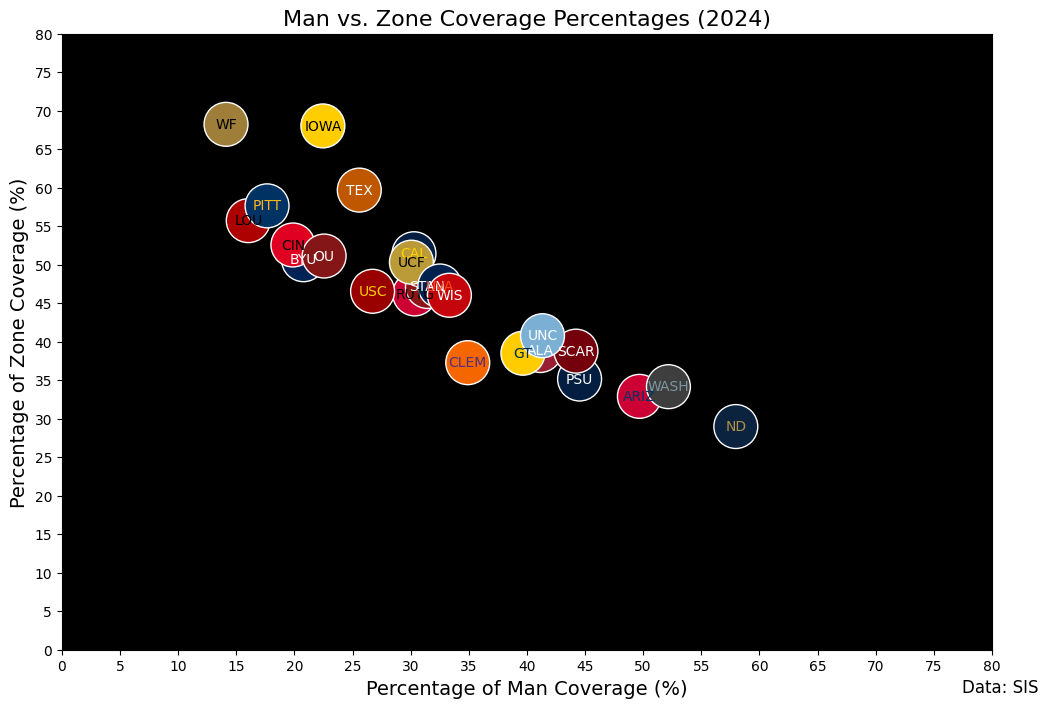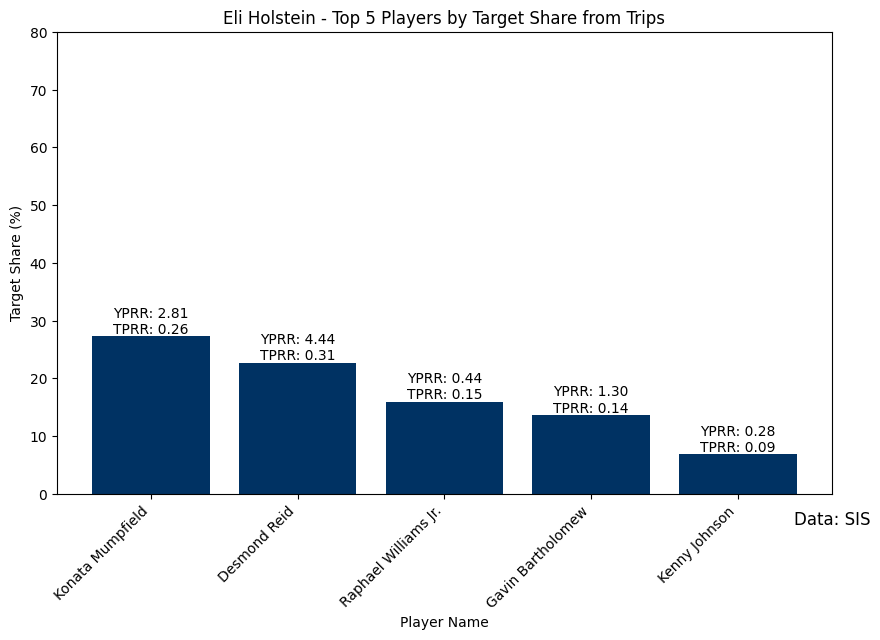CFB DFS DraftKings Main Slate Breakdown: Week 7

Using his experience as a former scout and staff member at Central Florida under Josh Heupel, Jordan Vanek takes an in-depth look at the upcoming CFB DFS main slate on DraftKings. Formerly of The 33rd Team and 4for4 Fantasy Football, Jordan will do a deep dive into the best stacks, running backs, and wide receivers before giving his overall thoughts on some slate strategy.
Week 6 was a disaster. The late news about Grayson McCall, followed by him getting injured on the first drive, really set me back. On top of that, chasing the contests with higher entry fees didn’t work out either. This weekend, I am planning to max-enter 150 lineups in the Mini Mid-Season Main Event, which has a $300,000 prize pool with $100,000 to 1st place. With that, I’ll be stacking more than I usually do.
Conference play is heating up, and we’ve got some exciting matchups ahead. The ACC, in particular, is lacking great defenses, and 3 of their games have totals set above 58 points. I’ll be trimming down my player pool as much as possible, but with so many strong options on the slate, it’ll be a challenge.
I’ll spend as much time as I can refining my lineups before the craziness of game day. I’ll also be tweaking my settings and making the most of our CFB DFS optimizer, LineupHQ, to get everything dialed in.
If you have any questions about my analysis or the slate overall, feel free to reach out in the RotoGrinders Discord.
Editor’s Note: Looking for more places to play? Check out our PrizePicks promo code and Underdog Fantasy promo code, two of the best DFS sites available today.
CFB DFS DraftKings Picks: Top Stacks, Running Backs, & Wide Receivers for Week 7
Now that we’re 6 weeks into the season, we can start to identify trends and adjustments based on matchups by analyzing coverage data from Sports Info Solutions. This data allows us to break down the defensive schemes that teams are deploying. Before diving into the specifics, there are a couple of important points to keep in mind. First, screen passes are excluded from this analysis, as it’s often difficult to accurately determine the defensive coverage on those plays. As a result, the coverage percentages you’ll see won’t add up to 100 percent.
With that in mind, let’s explore what the charts produce and why this information is crucial for building effective stacks and understanding matchups. By studying these trends, we can uncover valuable insights into how certain players can exploit specific defensive schemes, giving us a competitive edge when constructing lineups.
Single High vs. Two High

Single-high coverage refers to a defensive scheme where a single safety is positioned deep in the middle of the field, responsible for defending against deep passes and providing support over the top. This setup often leaves cornerbacks one-on-one with wide receivers, creating potential for big plays if the receivers win their matchups. Teams like Arizona, Notre Dame, Washington, and Wisconsin frequently employ this strategy.
Against Iowa, Washington will likely rely heavily on single-high coverage, aiming to bring an extra defender into the box to contain Kaleb Johnson. Similarly, given KJ Jefferson’s recent performance, I anticipate Cincinnati will utilize more single-high coverage to force UCF into throwing the ball. Aside from these scenarios, there aren’t many other notable standouts with this coverage scheme.
In contrast, two-high coverage positions two safeties deeper, each covering a half of the field. This provides greater protection against deep passes but can expose the defense to runs or shorter passes underneath. Teams like Iowa, Wake Forest, and Pittsburgh often use this strategy to prevent explosive passing plays.
Pittsburgh, however, is a unique two-high coverage team due to their aggressive blitzing. They are the only team in this group that blitzes at a high rate while in two-high coverage. Iowa’s two-high approach was picked apart by Ohio State, and looking at their schedule, any team with a decent passing attack has had success against their defense.
Man vs. Zone

Man coverage is a defensive scheme where a defender is assigned to cover a specific offensive player throughout the play. Teams that heavily rely on man coverage often align with those that use a lot of single-high coverage, such as Notre Dame, Washington and Arizona. These defenses trust their cornerbacks to handle receivers one-on-one, with minimal safety help. Washington blitzes when playing man coverage and will try to get you to throw hot to make the stop. They also have Bill Belichick’s son as their DC, and that aligns with how he operated in the NFL.
On the flip side, zone coverage tasks defenders with covering specific areas of the field rather than individual players. Though players might find themselves in man-to-man situations if an opponent enters their zone, their responsibilities are determined by the defensive call. Teams that frequently employ zone coverage include Pittsburgh, Iowa, Louisville, Wake Forest, and Texas.
I don’t see how Oklahoma can move the ball well against this Texas team without any of their top wide receivers, multiple offensive linemen out, and a true freshman QB. It’ll be very interesting to see how they look after the bye week and if Texas can continue to be the most dominant team in the country.
Stacks
Eli Holstein ($9,700, QB, Pittsburgh)
Desmond Reid ($9,400, RB, Pittsburgh)
Konata Mumpfield ($5,800, WR, Pittsburgh)
Corey Dyches ($3,100, WR, California)
Fernando Mendoza ($6,400, QB, California)

Pittsburgh’s offense has been on fire, scoring 34 or more points in 4 of their last 5 games, and they’re only getting better as the season progresses. Holstein has emerged as a dual-threat quarterback, rushing for over 50 yards in each of his last 3 games and throwing at least 3 touchdowns in every game this season. Although his price is high, Holstein has the potential to deliver big against a tough California defense that just held Cam Ward and the Miami Hurricanes in check.
I’m not hesitant to stack Reid with Holstein. Reid has been just as effective as a rusher as he has been a receiver, with multiple 100-yard games in both categories this season. Against California, I see him as a major mismatch against their linebackers. Pittsburgh likes to use trips formations and isolate Reid out of the backfield, a strategy that gave California problems against Miami’s similar trips concepts, which could hurt them again in this matchup. For a wide receiver, I’m targeting Mumpfield. Pittsburgh moves him around a lot in their trips formations and gets creative in finding ways to get him the ball.

I like the idea of a game stack here because I want to push the Pittsburgh passing game to stay aggressive. Cal’s passing game is also priced well for this strategy. Pittsburgh’s defense is designed to shut down the run and bring pressure on passing plays, playing a lot of zone coverage. This season, Dyches has been Mendoza’s go-to target, and he’s been the most productive against zone defenses, making him an ideal piece for this stack.

This content can help you make better CFB DFS picks
- To access this content, subscribe to CFB Premium or purchase a 3-day trial.
- A CFB subscription will allow you to access this content and much more!
About the Author
Jordan Vanek has been playing DFS since 2016. He attended the University of Central Florida, where he joined the football staff as a player personnel intern and participated in the recruitment of Dillon Gabriel and Ryan O’Keefe. Formerly of The 33rd Team and 4for4 Fantasy Football, Jordan joined the RotoGrinders team in 2024 and will be providing College Football and NFL DFS content for Premium subscribers. Follow Jordan on Twitter – @JordanVanekDFS
